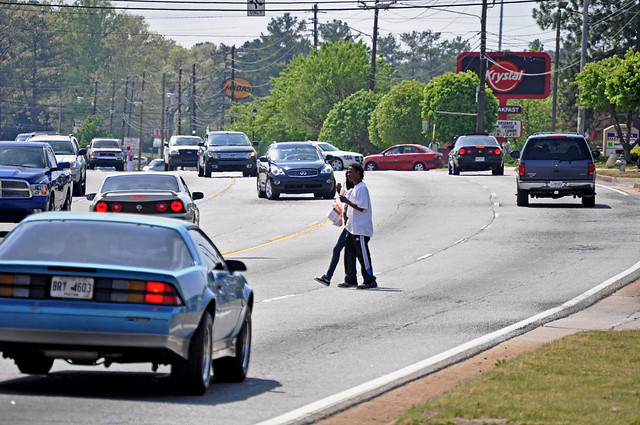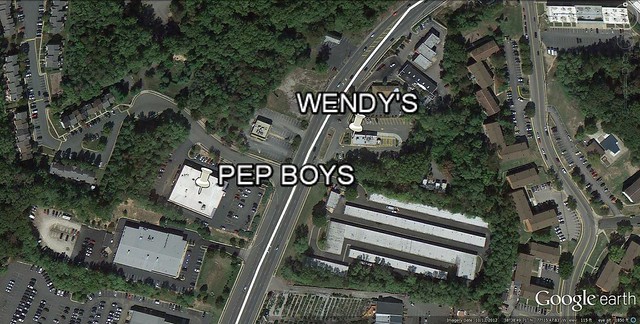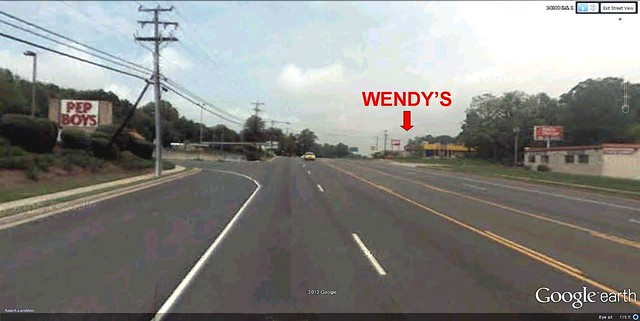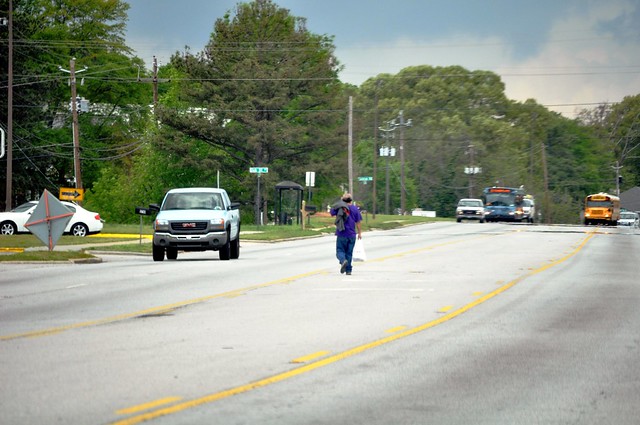The Daunting Challenge of Unwalkable America
(Today's article is excerpted and adapted from the 2014 book People Habitat: 25 Ways to Think About Greener, Healthier Cities, distributed by Island Press.)
This won't be breaking news to most readers, but Americans don't walk very much. Periodically, National Geographic publishes a 17-nation "Greendex" study on, among many other things, transit use and walking. In 2012 we Americans came in dead last on both indices, and it wasn't close.
In particular, only 34 percent of Americans reported walking to destinations (jobs, shopping, school, and so forth) "often" or "all of the time." Spaniards and Germans walk about twice as much. The rates for Britain and even notoriously cold and dark Sweden were substantially higher than those for the US. Speaking of cold, even the Canadians walk more than we do. We are also dead last in bicycling.
According to census data, the share of workers who commute to work by walking in the US is a measly 6.5 percent; bicycling adds another 1.3 percent. A slim majority of Americans drive alone to work, which also isn't exactly breaking news. (Transit comes in second at 26.5 percent.) Yet research out of Portland State University on "commute well-being" finds that bicycle commuters enjoy their trips to work the most, and those who drive alone enjoy their commute the least.
Inconvenient and dangerous
I suppose there are a number of reasons why we don't walk very much, particularly compared to residents of other countries. But surely a big one is that, for most Americans in most places, walking – that most basic and human method of movement, and the one most important to our health – is all but impossible. Maybe not literally impossible, but inconvenient at best, and tragically dangerous way too often. Except for traditional downtowns, few American communities even have things to walk to within safe and easy walking distance.
Walking is downright dangerous along many suburban commercial roads. Indeed, it should come as no surprise that sprawling, Sun Belt metro regions built completely around the automobile are statistically the nation's most unsafe places to walk. A report released by the nonprofit National Complete Streets Coalition earlier this year analyzed traffic fatality data over a ten-year period; the report found that the country's top four "most dangerous" metro regions for pedestrians are all in the state of Florida. Rounding out the top ten are regions in Texas, the Carolinas, Tennessee, Alabama and Arizona. (The National Complete Streets Coalition is a program of Smart Growth America; I am a board member of SGA but had no connection with the report.)
Here are the ten most unsafe metro areas in which to walk, according to the report:
- Orlando-Kissimmee, FL
- Tampa-St. Petersburg-Clearwater, FL
- Jacksonville, FL
- Miami-Fort Lauderdale-Pompano Beach, FL
- Memphis, TN-MS-AR
- Birmingham-Hoover, AL
- Houston-Sugar Land-Baytown, TX
- Atlanta-Sandy Springs-Marietta, GA
- Phoenix-Mesa-Scottsdale, AZ
- Charlotte-Gastonia-Concord, NC-SC
The organization also reports that more than 47,000 pedestrians were killed in the United States from 2003 through 2012, the equivalent of a jumbo jet full of passengers crashing roughly every month. On top of that, more than 676,000 pedestrians were injured over the decade, a number equivalent to a car or truck striking a pedestrian every 8 minutes.
The effect of roadway design
While pedestrian deaths are usually labeled as accidents by local authorities, the Complete Streets Coalition believes many are, in fact, attributable to poor roadway design that fails to safely accommodate walkers. Because walking is proven to be good for our health, lowering obesity rates, many people in these unsafe areas are forced to choose between an unhealthy lifestyle and an unsafe one. Children, older adults, and racial and ethnic minorities are disproportionately represented in pedestrian fatalities.
For example, consider Woodbridge, Virginia, about 25 miles south of downtown Washington, DC. The Google Earth satellite image below shows a section of the area's main drag, the US Route 1 corridor.
Home to the Potomac Mills discount mega-mall and not far from the Quantico Marine Corps base, Woodbridge is a diverse "census-designated place and magisterial district" whose population is 42 percent white, 28 percent black, and 32 percent Hispanic. It consisted mostly of farms and light industrial complexes until the 1980s, when it began to attract more suburban development. What you see in the satellite view are, among other things, several auto dealerships and automobile service facilities, some single-family homes, some apartments, a trailer park, and a self-storage facility. All seem sort of plopped down by happenstance.
What you don't see are any but the crudest accommodations for walking. No sidewalks, no crosswalks other than at long-distance intervals; this part of Woodbridge is a place for being either indoors or in a motor vehicle. (There's not much transit, either.) If you were, say, an employee at the Pep Boys auto parts store on the west side of Route 1, your spouse had dropped you off and kept the car for the day, and you wanted to grab a sandwich for lunch at Wendy's right across the street, you'd have to walk nearly a mile, round trip, to cross the road with the benefit of a traffic signal. You would lose at least half your lunch hour getting there and back. Even then, half your trip would have no sidewalk.
What many people with limited time would understandably do in that situation, instead, is attempt to cross the road using the shortest and most direct route between Pep Boys and Wendy's, despite intermittent traffic, and hope their instincts, quickness and powers of observation would enable them to do so without getting hit. Some people do exactly that, without consequence.
If a pedestrian does get hit by a motor vehicle, though, under Virginia law the pedestrian is at fault. In this place, cars come first in the eyes of the law, and anyone who fails to respect that axiom takes chances in more ways than one.
I mention all this because it's more or less what actually happens on this stretch of Route 1. Indeed, in late 2012 two men were hit by motor vehicles while trying to cross the road in separate incidents near the section of Route 1 that I marked. Both pedestrians were evacuated to the hospital, and both were charged by police with "interfering with traffic." The drivers were not charged.
A tragic case
A working single mother in suburban Atlanta named Raquel Nelson wasn't so lucky. In April of 2010, Nelson was charged and convicted of homicide after losing her four-year-old son while trying to cross a busy road after getting off a bus. My friend David Goldberg, who works for the national nonprofit Transportation for America (also a program of SGA), described the facts in a Washington Post opinion article:
"After a long bus trip with her three young children in April 2010, Raquel Nelson did what other bus passengers did that day, and had done so many days before: She attempted to cross the road from the bus stop, which is directly opposite her apartment complex, rather than walk a third of a mile to a traffic light, cross five lanes and walk a third of a mile back, lugging tired children and groceries.
"The family walked without incident to the three-foot median in the road. As they waited on the median for a break in traffic, Nelson's son A.J. followed other adults who crossed ahead of them. He was hit by a motorist who fled and later admitted to having been drinking and taking painkillers. The driver spent six months in jail and is serving the remainder of his five-year sentence on probation. Nelson was sentenced last week to 12 months' probation, fines and community service."
Wow. I haven't studied the details of Georgia law or all of the facts, but Nelson's conviction is stunning. Whatever her legal culpability, I find it shocking that Cobb County (northwest of Atlanta) officials chose to exercise their discretion to prosecute her for homicide. Goldberg continues:
"Nelson was found guilty of killing her son by crossing the road in the 'wrong' place. But what about the highway designers, traffic engineers, transit planners and land-use regulators who placed a bus stop across from apartments but made no provision whatsoever for a safe crossing? Those who ignored the fact that pedestrians always take the shortest possible route but somehow expected them to walk six-tenths of a mile out of their way to cross the street? Those who designed this road — which they allowed to be flanked by apartments and houses — for speeds of 50 mph and more? And those who designed the entire landscape to be hostile to people trying to get to work or carrying groceries despite having no access to a car? Are they not culpable?"
(Nelson was granted a retrial and, after further legal proceedings, prosecutors dropped the charge of homicide in 2013. She agreed to pay a $200 fine for jaywalking. )
What's the remedy?
For someone who cares about safe and healthy communities, what's the remedy? Jeff Speck's excellent 2012 book Walkable City provides terrific answers for some places, but they work best in downtowns and established cities. His "ten steps of walkability" to create urban environments that are more conducive to foot travel include such contextually effective measures as placing more housing downtown, restricting free parking, and running transit through dense urban corridors. If we do these things in downtown Boise or Houston or Greensboro or even Bakersfield, it is likely that we will, indeed, make the city more walkable.
But what the heck can putting a price on downtown parking do for people like Nelson in residential Cobb County or anyone in Woodbridge? Can we have a walkable city where we don't have a city in the first place? What if the location is just a "census-designated place" with a bunch of uncoordinated and unplanned properties that somehow ended up near each other along a high-speed road? The stretch of Route 1 in Woodbridge, in particular, is not remotely ready for more urban measures. The tragedy is that it's "urbanized" enough to have some foot traffic, but not urban enough to protect it.
I suppose one answer is that, as the economy allows new businesses and homes to be built in and around the bad stuff, we can gradually make the newer land uses better and more "walk-ready" over time, so that the place can function better for pedestrians when the good stuff reaches critical mass. Meaningful transformation might take a while, though, because many of these places are not the kind of prosperous communities where change is likely to occur rapidly and with the degree of investment necessary to do it right.
Back to Orlando, the region found most dangerous in the country, local officials told New York Times reporter Lizette Alvarez in 2011 that "the data is [sic] somewhat skewed by the number of tourists who visit the state, which inflates traffic." Nevertheless, Alvarez reported that local officials were taking the matter seriously, building sidewalks, installing audible pedestrian signals, increasing traffic calming, modifying bus stops, creating overpasses, and improving lighting.
Whatever the approach, it matters: a lot of places in America are like Cobb County and Woodbridge. And, if we don't start exercising more, including by walking, the prospects for our collective health are daunting. The single most alarming public health trend in the United States today is the dramatic rise in overweight and obesity, bringing serious risks of heart disease, diabetes and other consequences leading to life impairment and premature death.
While these health challenges are complex, with many factors at play, our country's sedentary lifestyle is an important one. In a massive study of half a million residents of Salt Lake County, researchers at the University of Utah found that an average-sized man weighed 10 pounds less if he lived in a walkable neighborhood – "those that are more densely populated, designed to be more friendly to pedestrians and have a range of destinations for pedestrians" – versus a less walkable one. A woman of average size weighed six pounds less. Other research has found that men and women age 50–71 who take a brisk walk nearly every day have a 27 percent reduced death rate compared to non-exercisers.
I have some hope for places like Orlando and even suburban Atlanta. As sprawling as they are, there is enough critical mass of residences and businesses to build upon, at least over time. Bus stops and businesses can be much better coordinated with crosswalks at reasonable intervals, for example, and measures such as those cited for Orlando can be put into place.
But I have a hard time seeing a near-term healthy solution for the Woodbridges of the country. In the meantime, I don't blame people outside of downtowns and larger, more conscientious cities who choose to get around on wheels rather than their feet.
Move your cursor over the images for credit information.





